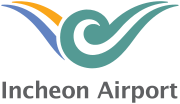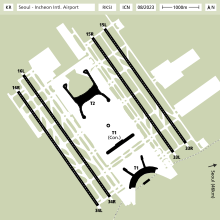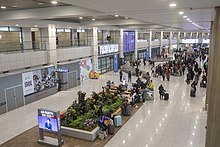Incheon airport
| Incheon Airport 인천 국제 공항 Incheon Gukje Gonghang |
|
|---|---|

|
|
| Characteristics | |
| ICAO code | RKSI |
| IATA code | ICN |
| Coordinates | |
| Height above MSL | 7 m (23 ft ) |
| Transport links | |
| Distance from the city center | 52 km west of Seoul |
| Local transport | various bus routes to Seoul and Incheon |
| Basic data | |
| opening | March 29, 2001 |
| operator | Incheon International Airport Corporation |
| surface | 5600 ha |
| Terminals | 2 |
| Passengers | 57,765,397 (2016) |
| Air freight | 2,714,341 t (2016) |
| Flight movements |
339,673 (2016) |
| Employees | 30,000 |
| Runways | |
| 15R / 33L | 3750 m × 60 m asphalt / concrete |
| 15L / 33R | 3750 m × 60 m asphalt / concrete |
| 16/34 | 4000 m × 60 m asphalt / concrete |
| Korean spelling | |
|---|---|
| Korean alphabet : | 인천 국제 공항 |
| Hanja : | 仁川 國際 空港 |
| Revised Romanization : | Incheon Gukje Gonghang |
| McCune-Reischauer : | Inch'ŏn Kukche Konghang |

The Incheon International Airport (ICN) (인천 국제 공항, Incheon Gukje Gongshang, dt. "Incheon International Airport") is the largest airport in South Korea and one of the largest in Asia . It is located on the Incheon island of Yeongjongdo in the Yellow Sea , 52 kilometers west of Seoul . The operating company is Incheon International Airport Corporation .
Incheon Airport is the hub of Korean Air and Asiana Airlines . The airport opened in 2001, replacing Gimpo International Airport in international air traffic . Gimpo now serves, apart from flights to Tokyo International Airport , Kansai International Airport , Beijing Airport , Taipei Songshan Airport and Shanghai Airport Hongqiao , only inter-Korean flights.
The airport forms the backbone for international civil air traffic and air freight transport in East Asia . In terms of traffic volume , it is the seventh largest airport in Asia, behind Haneda Airport ( Tokyo ), Beijing Airport ( Peking ), Hong Kong International Airport ( Hong Kong ), Suvarnabhumi Airport ( Bangkok ), Singapore Airport ( Singapore ), and Narita Airport (near Tokyo).
Transport links
The Expressway 130 connects the airport with the mainland, a part thereof is the Yeongjong bridge. In addition, there has been a second road connection over the Incheon Bridge since October 2009 . There are regular bus connections to all of South Korea , as well as ferry connections to Incheon and other nearby ports.
In addition, a motorway was completed between Incheon and Gimpo International Airport , which connects domestic air traffic with the international airport. An improvement that makes it a lot easier to travel from South Korean regions to Incheon and from there to any airport in the world. The Incheon International Airport Railroad connection to Gimpo International Airport connects the two airports in a good 30 minutes' drive. Extensions to the Seoul Central Station followed by the end of 2010.
As a special feature, in the approach lanes in the north and south, the letters "INCHEON", recognizable from a great height, are applied in 40-meter-high white letters.
Awards
The AETRA passenger survey in 2005 already showed that the airport was the best airport in its category. The airport was also awarded the Best Service Award at the first international conference on airport quality and service organized by IATA and ACI . In 2007 it was ranked second in the Best Airport World category , behind Hong Kong Airport but ahead of Singapore Airport . In 2009 he was finally able to advance to first place. This result is based on a survey of 8.6 million passengers at more than 190 airports worldwide. In 2011, the Airports Council International again voted the airport the best airport in the world for its quality of service.
history
The construction of the airport was divided into four phases.
Phase 1
Phase 1 was approved in 1992 and comprises the construction of a passenger terminal for 30 million PAX , a freight terminal and two runways .
Timetable
- February 1992: Approval of the overall plan
- November 1992: Phase I construction and preparation of the infrastructure
- July 1994: completion of the north and south dams
- March 1996: Formal naming: Incheon International Airport
- May 1996: Start of construction of the passenger terminal
- December 1996: Start of construction of the runway system
- June 30, 2000: Completion of the main buildings
- July 2000: Start of the test phase
- November 2000: Announcement of the opening
- March 29, 2001: Official opening
Phase 2
Phase 2 started in 2002 and was completed in time for the 2008 Summer Olympics in Beijing. It included the construction of a runway and a satellite .
Phase 3
Phase 3 comprised the construction of a second terminal and the associated transport connections. The freight terminal was also expanded. Four trillion South Korean won (around 3 billion euros) were forecast for this. The phase was completed in early 2018.
Phase 4
For phase 4 it is foreseen that Terminal 2 and the freight terminal will be expanded. In addition, two more runways are to be built.
Airport facilities
Runways
The airport has three runways . Two more are planned for the final expansion. All tracks run parallel.
Terminals
The airport has two terminals and a satellite. All of them are connected to each other on both land and air.
Terminal 1
Terminal 1 is the oldest terminal and was opened in 2001 together with the airport. It has a total of 44 gates, all of which are equipped with passenger boarding bridges. In 2008 it was expanded to include a satellite that has 30 additional gates and has since served mainly all foreign airlines. Terminal and satellite are connected underground with the so-called IAT (Intra Airport Transit).
Terminal 2
Terminal 2 was officially opened on January 18, 2018. It serves as a hub for Korean Air and its SkyTeam partners Air France , KLM and Delta Air Lines . Other SkyTeam companies are to follow. A train station, a bus terminal and multi-storey car parks are directly connected to the terminal.
In the future, the piers in the east and west of the terminal are planned to be extended to the north, which would then give it the shape of an H.
Terminal 3
For the final expansion, a third passenger terminal is planned to be built east of Terminal 1 and south of the freight terminal.
Freight terminal
The freight terminals are in the east. In addition to Asiana Airlines Cargo and Korean Air Cargo, the main users are FedEx, DHL Aviation and UPS Airlines. Work has already started to expand the freight terminal to the north.
Traffic figures
| year | Passenger volume |
Freight volume (in tons) |
Flight movements |
|---|---|---|---|
| from 03/2001 | 14,542,290 | 1,186,015 | 86,807 |
| 2002 | 20,924,171 | 1,705,928 | 126.094 |
| 2003 | 19,789,874 | 1,843,055 | 130.185 |
| 2004 | 24,084,072 | 2,133,444 | 149,776 |
| 2005 | 26.051.466 | 2,150,139 | 160.843 |
| 2006 | 28.191.116 | 2,336,571 | 182.007 |
| 2007 | 31,227,897 | 2,555,580 | 211,404 |
| 2008 | 29,973,522 | 2,423,717 | 211.102 |
| 2009 | 28,549,770 | 2,313,002 | 198.918 |
| 2010 | 33,478,925 | 2,684,499 | 214,835 |
| 2011 | 35,062,366 | 2,539,222 | 229,580 |
| 2012 | 38,970,864 | 2,456,724 | 254.037 |
| 2013 | 41,482,828 | 2,464,385 | 271.224 |
| 2014 | 45,512,099 | 2,557,681 | 290.043 |
| 2015 | 49.281.210 | 2,595,677 | 305,446 |
| 2016 | 57,765,397 | 2,714,341 | 339.673 |
swell
- ↑ a b c d Airport Statistics / Airport Traffic (Summary). (No longer available online.) Archived from the original on June 26, 2013 ; accessed on March 23, 2015 (English). Info: The archive link was inserted automatically and has not yet been checked. Please check the original and archive link according to the instructions and then remove this notice.
- ↑ Airport Service Excellence Awards for 2005. ACI , March 7, 2006, accessed on March 23, 2015 (English).
- ↑ Passenger survey : South Korea has the best airport. SPON , June 10, 2009, accessed March 23, 2015 .
- ^ Incheon International Airport named Best Airport Worldwide. ACI , February 15, 2011, accessed March 23, 2015 .
- ↑ a b Video: Incheon Airport 3rd Construction Phase. youtube, 2017, accessed December 3, 2017 .
- ↑ Seoul is happy about the new terminal. aerotelegraph, 2017, accessed December 3, 2017 .
See also
Web links
- Official website of the airport
- New Airport Highway Co.- Incheon International Airport Expressway



